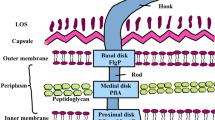Abstract
When corn stunt spiroplasma (CSS) was grown in spiroplasma medium A (SMA) containing 5% horse serum, 16% sucrose, 1.5% PPLO broth, and 0.002% phenol red indicator, color and pH of the medium changed from red (pH 7.5) to yellow (pH 5.8) by 4 days after inoculation with CSS. In spiroplasma medium B (SMB), identical to SMA except for supplementation with 47 mM arginine-HCl, color and pH changed within 4 days but reverted to red (pH 7.5) 6 days later, suggesting that arginine was metabolized. Growth of CSS in both SMA and SMB was a characteristic sigmoid pattern; maximum titers were reached the fifth day after inoculation and were 2.3 × 108 cells/ml in SMA and 4.5×108 cells/ml in SMB. Helicity and motility of CSS were lost after 8 days in SMA, while in SMB some cells were still helical and motile up to 15 days. Daily analyses of CSS cultures by photometric methods showed that arginine was depleted from SMB and production of ammonia and ornithine was higher in SMB than in SMA; citrulline was detected in SMB but urea was not found in either medium. Results from additional tests using an amino acid analyzer and thin-layer chromatography further substantiated arginine metabolism and indicated that an arginine deiminase pathway was operative in CSS.
Similar content being viewed by others
Literature Cited
Abdelal, A. T. 1979. Arginine catabolism by microorganisms. Annual Review of Microbiology33:139–168.
Aluotto, B. B., Wittler, R. G., Williams, C. O., Faber, J. E. 1970. Standardized bacteriologic techniques for the characterization ofMycoplasma species. International Journal of Systematic Bacteriology20:35–58.
Archibald, R. M. 1945. Colorimetric determination of urea. Journal of Biological Chemistry157:507–518.
Barile, M. F., Schimke, R. T., Riggs, D. B. 1966. Presence of the arginine dihydrolase pathway inMycoplasma. Journal of Bacteriology91:189–192.
Chen, T. A., Liao, C. H. 1975. Corn stunt spiroplasma: Isolation, cultivation, and proof of pathogenicity. Science188:1015–1017.
Chinard, F. P. 1952. Photometric estimation of proline and ornithine. Journal of Biological Chemistry199:91–95.
Davis, R. E., Worley, J. F., Clark, T. B., Moseley, M. 1976. New spiroplasma in diseased honeybee (Apis mellifera L.): Isolation, pure culture, and partial characterizationin vitro. Proceedings of the American Phytopathological Society3:304.
Ford, R. E., Tu, J. C. 1969. Free amino acid contents in corn infected with maize dwarf mosaic virus and sugarcane mosaic virus. Phytopathology59:179–182.
Hahn, R. G., Kenny, G. E. 1974. Differences in arginine requirement for growth among arginine-utilizingMycoplasma species. Journal of Bacteriology117:611–618.
Hunninghake, D., Grisolia, S. 1966. A sensitive and convenient micromethod for estimation of urea, citrulline and carbamyl derivatives. Analytical Biochemistry16:200–205.
Igwegbe, E. C. K. 1975. Possible hydrolysis of arginine bySpiroplasma citri strains. Proceedings of the American Phytopathological Society2:44.
Igwegbe, E. C. K. 1978. High concentrations of horse serum inhibit growth of corn stunt spiroplasma. Applied and Environmental Microbiology35:146–148.
Igwegbe, E. C. K., Thomas, C., Morgan, J. 1975. Effect of arginine on growth ofSpiroplasma citri. Proceedings of the American Phytopathological Society2:44.
Igwegbe, E. C. K., Thomas, C. 1978. Occurrence of enzymes of arginine dihydrolase pathway inSpiroplasma citri. Journal of General and Applied Microbiology24:261–269.
Igwegbe, E. C. K., Stevens, C., Hollis, J. J., Jr. 1979. Anin vitro comparison of some biochemical and biological properties of California and Morocco isolates ofSpiroplasma citri. Canadian Journal of Microbiology25:1125–1132.
Liao, C. H., Chen, T. A. 1977. Culture of corn stunt spiroplasma in a simple medium. Phytopathology67:802–807.
Purcell, R. H., Taylor-Robinson, D., Wong, D., Chanock, R. M. 1966. Color test for the measurement of antibody to T-Strain mycoplasmas. Journal of Bacteriology92:6–12.
Rosenberg, H., Ennor, A. H., Morrison, J. F. 1956. The estimation of arginine. Biochemical Journal63:153–159.
Saglio, P., Lhôspital, M., Laflèche, D., Dupont, G., Bové, J. M., Tulley, J. G., Freundt, E. A. 1973.Spiroplasma citri gen. and sp. n.: A mycoplasma-like organism associated with “stubborn” disease of citrus. International Journal of Systematic Bacteriology23:191–204.
Scheiner, D. 1976. Determination of ammonia and Kjeldahl nitrogen by indophenol method. Water Research10:31–36.
Schimke, R. T., Barile, M. F. 1963. Arginine metabolism in pleuropneumonia-like organisms isolated from mammalian cell culture. Journal of Bacteriology86:195–206.
Schimke, R. T., Berlin, C. M., Sweeney, E. W., Carroll, W. R. 1966. The generation of energy by the arginine dihydrolase pathway inMycoplasma hominis 07. Journal of Biological Chemistry241:2228–2236.
Schmidt, G. C., Logan, M. A., Tytell, A. A. 1952. The degradation of arginine byClostridium perfringens (BP6K). Journal of Biological Chemistry198:771–783.
Stevens, C., Cody, R. M., Gudauskas, R. T. 1977. Arginine metabolism by corn stunt spiroplasma. Proceedings of the American Phytopathological Society4:170.
Stevens, C., Cody, R. M., Gudauskas, R. T. 1977. Effects of arginine on growth and helicity of corn stunt spiroplasma. Proceedings of the American Phytopathological Society4:229.
Townsend, R. 1976. Arginine metabolism bySpiroplasma citri. Journal of General Microbiology94:417–420.
Williams, G. A., Blazevic, D. J., Ederer, G. M. 1971. Detection of arginine dihydrolase in nonfermentative gram-negative bacteria by use of thin-layer chromatography. Applied Microbiology22:1135–1137.
Williamson, D. L., Whitcomb, R. F. 1975. Plant mycoplasma: A cultivable spiroplasma causes corn stunt disease. Science188:1018–1020.
Author information
Authors and Affiliations
Rights and permissions
About this article
Cite this article
Stevens, C., Cody, R.M. & Gudauskas, R.T. Arginine metabolism by the corn stunt spiroplasma. Current Microbiology 4, 139–142 (1980). https://doi.org/10.1007/BF02602816
Issue Date:
DOI: https://doi.org/10.1007/BF02602816




